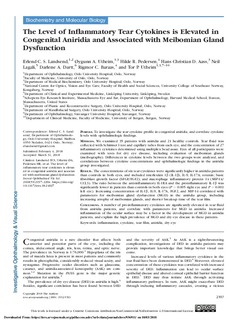| dc.contributor.author | Landsend, Erlend Christoffer Sommer | |
| dc.contributor.author | Utheim, Øygunn Aass | |
| dc.contributor.author | Pedersen, Hilde Røgeberg | |
| dc.contributor.author | Aass, Hans Christian Dalsbotten | |
| dc.contributor.author | Lagali, Neil | |
| dc.contributor.author | Dartt, Darlene Ann | |
| dc.contributor.author | Baraas, Rigmor C. | |
| dc.contributor.author | Utheim, Tor Paaske | |
| dc.date.accessioned | 2018-10-05T06:27:48Z | |
| dc.date.available | 2018-10-05T06:27:48Z | |
| dc.date.created | 2018-06-06T14:34:49Z | |
| dc.date.issued | 2018 | |
| dc.identifier.citation | Investigative Ophthalmology and Visual Science. 2018, 59 (5), 2197-2204. | nb_NO |
| dc.identifier.issn | 0146-0404 | |
| dc.identifier.uri | http://hdl.handle.net/11250/2566542 | |
| dc.description | This work is licensed under a Creative Commons Attribution-NonCommercial-NoDerivatives 4.0 International License. | nb_NO |
| dc.description.abstract | Purpose: To investigate the tear cytokine profile in congenital aniridia, and correlate cytokine levels with ophthalmologic findings.
Methods: We examined 35 patients with aniridia and 21 healthy controls. Tear fluid was collected with Schirmer I test and capillary tubes from each eye, and the concentration of 27 inflammatory cytokines determined using multiplex bead assay. Eyes of all participants were examined with tests for dry eye disease, including evaluation of meibomian glands (meibography). Differences in cytokine levels between the two groups were analyzed, and correlations between cytokine concentrations and ophthalmologic findings in the aniridia group investigated.
Results: The concentrations of six tear cytokines were significantly higher in aniridia patients than controls in both eyes, and included interleukin 1β (IL-1β), IL-9, IL-17A; eotaxin; basic fibroblast growth factor (bFGF/FGF2); and macrophage inflammatory protein 1α (MIP-1α/CCL3). The ratio between the anti-inflammatory IL-1RA and the proinflammatory IL-1β was significantly lower in patients than controls in both eyes (P = 0.005 right eye and P = 0.001 left eye). Increasing concentration of IL-1β, IL-9, IL-17A, FGF2, and MIP-1α correlated with parameters for meibomian gland dysfunction (MGD) in the aniridia group, including increasing atrophy of meibomian glands, and shorter break-up time of the tear film.
Conclusions: A number of pro-inflammatory cytokines are significantly elevated in tear fluid from aniridia patients, and correlate with parameters for MGD in aniridia. Increased inflammation of the ocular surface may be a factor in the development of MGD in aniridia patients, and explain the high prevalence of MGD and dry eye disease in these patients. | nb_NO |
| dc.language.iso | eng | nb_NO |
| dc.rights | Attribution-NonCommercial-NoDerivatives 4.0 Internasjonal | * |
| dc.rights.uri | http://creativecommons.org/licenses/by-nc-nd/4.0/deed.no | * |
| dc.title | The level of inflammatory tear cytokines is elevated in congenital Aniridia and associated with meibomian gland dysfunction | nb_NO |
| dc.title.alternative | The level of inflammatory tear cytokines is elevated in congenital Aniridia and associated with meibomian gland dysfunction | nb_NO |
| dc.type | Journal article | nb_NO |
| dc.type | Peer reviewed | nb_NO |
| dc.description.version | publishedVersion | nb_NO |
| dc.rights.holder | (c) 2018 The Authors | nb_NO |
| dc.source.pagenumber | 2197-2204 | nb_NO |
| dc.source.volume | 59 | nb_NO |
| dc.source.journal | Investigative Ophthalmology and Visual Science | nb_NO |
| dc.source.issue | 5 | nb_NO |
| dc.identifier.doi | 10.1167/iovs.18-24027 | |
| dc.identifier.cristin | 1589495 | |
| cristin.unitcode | 222,56,2,0 | |
| cristin.unitcode | 222,56,0,0 | |
| cristin.unitname | Institutt for optometri, radiografi og lysdesign | |
| cristin.unitname | Fakultet for helse- og sosialvitenskap | |
| cristin.ispublished | true | |
| cristin.fulltext | original | |
| cristin.qualitycode | 2 | |

